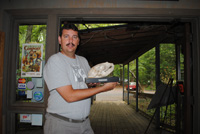Editorial
Front Page - Friday, September 17, 2010
Bears visiting residential areas should be viewed with awe and caution
Erica Tuggle
 Kyle Waggoner, the educational director at the Chattanooga Nature Center, holds up the skull of a black bear. Bears are an uncommon site out of the wilderness, but when they become a nuisance, it is almost always the result of a “people problem,” Waggoner says.
- Erica Tuggle
Kyle Waggoner, the educational director at the Chattanooga Nature Center, holds up the skull of a black bear. Bears are an uncommon site out of the wilderness, but when they become a nuisance, it is almost always the result of a “people problem,” Waggoner says.
- Erica Tuggle
In mid-July, a bear appearing in backyards and making attempts at entering homes in the Ooltewah area was killed by a resident citing safety concerns. Wildlife experts agree that the increasing frequency of bears in residential areas of Hamilton County is affected by several people centered factors.
Daryll Ratajczak is the Tennessee Wildlife Resource agency’s big game coordinator. He says that when a bear does get into a nuisance situation, it is generally traced back to the bear being fed by people.
He says, “For the most part, bears are wild animals, and they will stay up in the mountains, but sometimes they come down in search of food, and when they find food readily available around people’s homes, bears find that as an easy source of food.”
Ratajczak says that bears are highly intelligent animals and are able to realize that hanging around houses can sometimes lead to an easy meal. With this intelligence comes a loss of fear of humans that make the animals extremely brave, and in the worst-case scenario, involves bears breaking into houses, he says.
“All of that can be stopped right on the front end if people are more wary of the food outside their house in pet food bowls or even garbage cans,” he says.
The Tennessee Wildlife Res-
ource Agency watches over the bear population and has seen an increase in their numbers, growing consistently, for the past 50 years, Ratajczak says. Anywhere from 2,000 to 4,000 bears exist in the Tennessee area all along the eastern border of North Carolina and up to the Virginia border. Although the Unaka Mountain Range is their primary habitat, because of increasing numbers, bears are “literally bursting out the seams in some areas,” he says.
Cynthia Housley is an Ooltewah resident who lives in the area the bear that was killed frequently visited. She says she heard the bear rustling behind her house, grunting and making noise. Housley had a lot of wild animals around her home growing up, and so she wasn’t too worried about the bear’s visits. It is an everyday occurrence to see deer and turkey around her home all the time these days, she says.
“All the houses they are building and the subdivisions and lots of growth is pushing animals into these areas,” she says. “They have no where else to go.”
“[Living alongside bears] is something that can be done and is done all across the country, and anyone that has concerns or questions can always call the regional office of the Tennessee Wildlife Resource Agency in their area and talk to a biologist to see what they need to do to live peacefully with bears,” Retajczak says.
If a person does come into contact with a bear, Retajczak suggests using common sense while enjoying the rare sighting of a bear in or from the wild.
“Don’t do anything that wouldn’t be advisable, like getting close to the bear to take pictures,” he says. “They are extremely shy animals and rarely do they pose a threat, although that is a potential. Consider yourself lucky to have seen a bear in the wild; they are amazing creatures.”
Kyle Waggoner, the director of education and lead naturalist at the Chattanooga Nature Center, agrees that a bear problem in an area happens “almost always when people are doing something they shouldn’t be.”
He says, “A lot of times people are even feeding the bear because they think it is cute until they realized the bear was big and strong, and when he wanted food, he was going to take it.”
A combination of three things is bringing bears into the residential areas, he says. The wildlife populations are resurging, the human population is growing and moving into animal habitat and the number of farms that had previously acted as a buffer zone between the wilderness and the city have dwindled, Waggoner says.
“[Seeing bears] is going to become more and more common as their population increases and we start encroaching on their habitat,” he says. “This time of year, they are fattening up for hibernation ... so they are going to be really hungry and looking for food sources.”
He says that during his backpacking trips he has never had a problem when he has encountered bears; every time a bear saw him, it took off running as fast as it could.
He says if a bear is near your house, scare them away with loud noises to negatively reinforce the bear about your yard. Only feed birds in the wintertime, when bears are hibernating, and invest in a bear-proof garbage can.
“If you do all that, your chances of having a bear problem are going to be very, very low,” he says.
For more information on bear safety and tips visit www.tnwildlife.org.
|
|